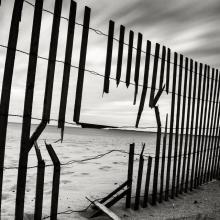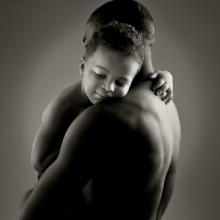race in america
TO CROSS THE border into Lesotho — a landlocked, mountainous country surrounded entirely by South Africa — my friends and I rented a 4x4 and drove up the icy Sani Pass. We switchbacked up one of the most dangerous roads in the world and almost skidded off the cliff.
Slightly shaken but unscathed, we experienced time stretching as we drove through the pastoral city of Mokhotlong, dotted with thatch-roofed mud-and-stone huts. Herds of sheep, in no hurry to make way, blocked the dirt road.
We walked along the deserted street, admiring handicrafts at a rug shop before popping into a grocery store. I was surprised when a Chinese couple greeted us from behind the counter with a warm, “Ni hao.” As my friends and I spoke with them in rudimentary Mandarin (four of us were Chinese American, the fifth was white American), I learned that they had been living in Mokhotlong for many years, raising a family while running the store. We shared a laugh about the unlikelihood of Chinese people finding one another in these hinterlands and, after buying a couple of sodas, went on our way.
Down the road, we discovered another grocery store, staffed by a Chinese couple from a different province in China. What a wild fluke, I thought, that such an isolated town would have two Chinese-owned markets! I soon learned that it wasn’t a fluke at all — Chinese people are present in virtually every nation in Africa, whether as contracted laborers or as informal migrants. Since July 2008, when I visited Lesotho while living in South Africa for two months, the Chinese population in Africa has increased to more than 1 million, including large populations in South Africa, Madagascar, and Zambia but also scattered throughout smaller communities in South Sudan, Togo, and Senegal.
The awe of meeting Chinese people in rural Africa prompted me to examine my family’s migration story and my sense of otherness in the U.S. My parents left Hong Kong to come to the U.S. for college, planting roots here for the freedom and opportunities that didn’t exist back home. Shortly before I was born, they became Christians through a Chinese immigrant church in the Bay Area. When I was 3 years old, we resettled near the University of Iowa, where my dad worked as a cardiologist.
While my parents were members of a small but vibrant Chinese church, by junior high I started attending a large, white, evangelical church where I could fully understand the English language worship service and have peers my age. Bathed in a white-dominant environment both at school and at church, I subconsciously believed that my differences made me inferior and that white male theologians were the arbiters of true Christianity — after all, they were the only people preaching or quoted from the pulpit. This led me to “the misguided belief,” as Grace Ji-Sun Kim writes, “that white knowledge, theology, and spirituality were far greater than anything we had ever possessed.”
IN HER STUNNING second novel, Brit Bennett, author of The Mothers, once again examines race and kinship. This time, she interrogates the color line through the Vignes twins—their coming of age and its impact on the subsequent generation. Born and raised in the fictional town of Mallard, La., the twins dream of escaping their stifling community. At 16, they run away together. In New Orleans, a desperate choice severs their bond: Stella passes as white to get a job, then leaves her sister Desiree in order to marry a white man.
Years later, when Desiree flees an abusive marriage and returns to Mallard with her daughter, Jude, the town is shocked by the child’s color: “black as tar,” “blueblack.” Having inherited her father’s complexion, Jude looks nothing like her mother. From its opening pages, The Vanishing Half grounds us in this “strange” town that, “like any other, was more idea than place.” The idea: a community for those “who would never be accepted as white but refused to be treated like Negroes.” An idea born of a freed slave, the twins’ ancestor, as he “stood in the sugarcane fields he’d inherited from the father who’d once owned him.”
Lent is our season of honesty. It is a time when we may break out of our illusions to face the reality of our life in preparation for Easter, a radical new beginning.
When, through this illusion-breaking homework, we connect with reality, we see that in our society the fabric of human community is almost totally broken. One glaring evidence of such brokenness is the current unrelieved tension between police and citizens in Ferguson, Missouri.
That tension is rooted in very old racism. It also reflects the deep and growing gap between “the ownership class” that employs the police and those who have no serious access to ownership who become victims of legalized violence.
This is one frontal manifestation of “the covenant that they broke,” as referred to in the Jeremiah text for this week: a refusal of neighborly solidarity that leads, with seeming certitude, to disastrous social consequences.
Of course the issue is not limited to Ferguson but is massively systemic in U.S. society. The brokenness consists not so much in the actual street violence perpetrated in that unequal contest. The brokenness is that such brutalizing force is accepted as conventional, necessary, and routine. It is a policy and a practice of violence acted out as “ordinary” that indicates a complete failure of neighborly imagination.
Lent is a time for honesty that may disrupt the illusion of well-being that is fostered by the advocates of indulgent privilege and strident exceptionalism that disregards the facts on the ground. Against such ideological self-sufficiency, the prophetic tradition speaks of the brokenness of the covenant that makes healthy life possible.
As long as there is denial and illusion, nothing genuinely new can happen. But when reality is faced — in this case the reality of a failed covenant between legal power and vulnerable citizens — new possibility becomes imaginable.
Howard Thurman says three things, in Jesus and the Disinherited: One — God is on the side of the oppressed and the poor. Know that God is on your side. Two — Dishonesty takes you out of the conversation. And if you live an honest life, if you have integrity, you can sit at the table. In areas of race, people look for holes in your character as excuses for you not to be at the table. Three — Hate is useless. Don’t let hate sink into your soul, because hate will destroy you. And respond with love even if it’s hard. So I try to teach my boys that, and raise them that way.



